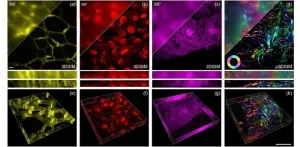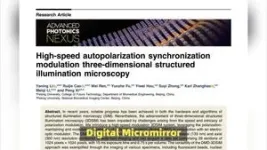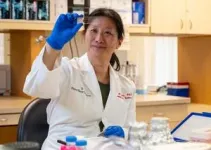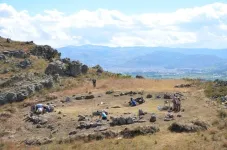(Press-News.org) In the ever-evolving realm of microscopy, recent years have witnessed remarkable strides in both hardware and algorithms, propelling our ability to explore the infinitesimal wonders of life. However, the journey towards three-dimensional structured illumination microscopy (3DSIM) has been hampered by challenges arising from the speed and intricacy of polarization modulation.
Introducing the DMD-3DSIM System
Enter the high-speed modulation 3DSIM system “DMD-3DSIM,” combining digital display with super-resolution imaging, allowing scientists to see cellular structures in unprecedented detail. As reported in Advanced Photonics Nexus, Professor Peng Xi's team at Peking University developed this innovative setup around a digital micromirror device (DMD) and an electro-optic modulator (EOM). It tackles resolution challenges by significantly improving both lateral (side-to-side) and axial (top-to-bottom) resolution, for a 3D spatial resolution reportedly twice that achieved by traditional wide-field imaging techniques.
Polarized insight into cellular structures
In practical terms, this means DMD-3DSIM can capture intricate details of subcellular structures, such as the nuclear pore complex, microtubules, actin filaments, and mitochondria in animal cells. The system's application was extended to study highly scattering plant cell ultrastructures, such as cell walls in oleander leaves and hollow structures in black algal leaves. Even in a mouse kidney slice, the system revealed a pronounced polarization effect in actin filaments.
An open gateway to discovery
What makes DMD-3DSIM even more exciting is a commitment to open science. Xi's team has made all the hardware components and control mechanisms openly available on Github, fostering collaboration and encouraging the scientific community to build upon this technology.
The DMD-3DSIM technique not only facilitates significant biological discoveries but also lays the groundwork for the next generation of 3DSIM. In applications involving live cell imaging, advancements in brighter and more photostable dyes, denoising algorithms, and deep learning models based on neural networks promise to enhance imaging duration, information retrieval, and real-time restoration of 3DSIM images from noisy data. By combining hardware and software openness, the researchers hope to pave the way for the future of multidimensional imaging.
For more details, read the original Gold Open Access article by Y. Li, R. Cao, et al., “High-speed autopolarization synchronization modulation three-dimensional structured illumination microscopy,” Adv. Photon. Nexus 3(1) 016001 (2023), doi 10.1117/1.APN.3.1.016001.
END
Super-resolution microscopy harnesses digital display technology
Microscopy breakthrough combines digital display with super-resolution for high-speed imaging to facilitate biological discovery
2024-02-14
ELSE PRESS RELEASES FROM THIS DATE:
UW anthropologists’ research unveils early stone plaza in the Andes
2024-02-14
Two University of Wyoming anthropology professors have discovered one of the earliest circular plazas in Andean South America, showcasing monumental megalithic architecture, which refers to construction that uses large stones placed upright with no mortar.
Located at the Callacpuma archaeological site in the Cajamarca Basin of northern Peru, the plaza is built with large, vertically placed megalithic stones -- a construction method previously unseen in the Andes. Associate Professor Jason Toohey, project lead, and Professor Melissa Murphy have been researching ...
New epigenetic clocks reinvent how we measure age
2024-02-14
BOSTON – What causes us to age? New “clocks” developed by researchers may help point to the answers. Investigators from Brigham and Women’s Hospital, a founding member of the Mass General Brigham healthcare system, unveil a new form of epigenetic clock – a machine learning model designed to predict biological age from DNA structure. The novel model distinguishes between genetic differences that slow and accelerate aging, predicts biological age and evaluates anti-aging ...
The roles of USP1 in Ewing sarcoma
2024-02-14
“This study uncovered important roles for USP1 in Ewing sarcoma.”
BUFFALO, NY- February 14, 2024 – A new research paper was published in Genes & Cancer on February 5, 2024, entitled, “Roles of USP1 in Ewing sarcoma.”
Ewing sarcoma is a cancer of bone and soft tissue in children and young adults that is driven by the EWS-ETS fusion transcription factor, most commonly EWS-FLI1.
Researchers Panneerselvam Jayabal, Xiuye Ma and Yuzuru Shiio from The University of Texas Health Science Center previously reported that Ewing sarcoma harbors two populations of cells, ...
New algorithm disentangles intrinsic brain patterns from sensory inputs
2024-02-14
Maryam Shanechi, Dean’s Professor of Electrical and Computer Engineering and founding director of the USC Center for Neurotechnology, and her team have developed a new machine learning method that reveals surprisingly consistent intrinsic brain patterns across different subjects by disentangling these patterns from the effect of visual inputs.The work has been published in the Proceedings of the National Academy of Sciences (PNAS).
When performing various everyday movement behaviors, such as reaching for a book, our brain has to take in information, often in the form of visual input — for example, seeing where the book is. Our brain then has to process ...
A new test could predict how heart attack patients will respond to mechanical pumps
2024-02-14
Every year, around 50,000 people in the United States experience cardiogenic shock — a life-threatening condition, usually caused by a severe heart attack, in which the heart can’t pump enough blood for the body’s needs.
Many of these patients end up receiving help from a mechanical pump that can temporarily help the heart pump blood until it recovers enough to function on its own. However, in nearly half of these patients, the extra help leads to an imbalance between the left and right ventricles, which can pose danger to the patient.
In a ...
Turning back the clock on photoaging skin
2024-02-14
Chronic exposure of human skin to ultraviolet light causes premature aging, or photoaging. As the skin undergoes photoaging, type I collagen bundles, which are found in the dermis beneath the top layer of the skin and provide strength and support to skin, become fragmented. This leads to wrinkles, fragility and loss of support and elasticity.
“The best way to prevent damage to type I collagen by sunlight is to wear sunscreen consistently, daily if possible and particularly when spending time outdoors,” said Frank Wang, MD, the William B. Taylor Endowed Professor of Clinical Dermatology at U-M Medical School.
Experts ...
City of Hope research featuring the successful treatment of the oldest patient to achieve remission for leukemia and HIV published in The New England Journal of Medicine (NEJM)
2024-02-14
LOS ANGELES — City of Hope®, one of the largest cancer research and treatment organizations in the United States, treated the oldest person to be cured of a blood cancer and then achieve remission for HIV after receiving a blood stem cell transplant from a donor with a rare genetic mutation. Research published in NEJM today demonstrates that older adults with blood cancers who receive reduced intensity chemotherapy before a stem cell transplant with donor cells that are resistant to HIV may be cured of HIV infection.
Paul Edmonds, 68, of Desert Springs, California, is the fifth person in the world to achieve remission for acute myelogenous leukemia ...
A lighthouse in the Gobi desert
2024-02-14
Los Angeles, CA (February 14, 2024) — A new study published in the journal PLOS ONE explores the weight great fossil sites have on our understanding of evolutionary relationships between fossil groups—the lagerstätten effect—and for the first time, quantified the power these sites have on our understanding of evolutionary history. Surprisingly, the authors discovered that the wind-swept sand deposits of the Late Cretaceous Gobi Desert’s extraordinarily diverse and well-preserved ...
Paradigm Shift: How a risk-based program is changing health care use and outcomes for children with high-risk asthma
2024-02-14
Le Bonheur’s risk-based innovation program Changing High-Risk Asthma in Memphis through Partnership (CHAMP) significantly decreased health care use related to asthma by targeting barriers to asthma care, according to research published in the Annals of Allergy, Asthma & Immunology. After one year of enrollment in the program, results analyzing 945 children included a 48% reduction in Emergency Department (ED) visits, 68% reduction in inpatient and observation visits, 42% reduction in urgent care visits and 53% reduction in asthma exacerbations. Asthma exacerbations per patient significantly decreased from 2.97 to 1.4.
“Children ...
U of M research advances potential HIV cure strategy
2024-02-14
Published in the Journal of Infectious Diseases Oxford Academic, research led by the University of Minnesota Medical School offers a new avenue of hope in the fight against chronic human immunodeficiency virus (HIV) infection.
The researchers explored the use of Natural Killer (NK) cells aiming to restore their function for better infection control — an approach that could be used in a broader HIV cure strategy as multiple companies are working on mass production of healthy NK cells.
“HIV has really excellent therapies thanks to the unprecedented progress in developing antiretroviral therapy, ...
LAST 30 PRESS RELEASES:
University of Oklahoma researcher awarded funding to pursue AI-powered material design
Exploring how the visual system recovers following injury
Support for parents with infants at pediatric check-ups leads to better reading and math skills in elementary school
Kids’ behavioral health is a growing share of family health costs
Day & night: Cancer disrupts the brain’s natural rhythm
COVID-19 vaccination significantly reduces risk to pregnant women and baby
The role of vaccination in maternal and perinatal outcomes associated with COVID-19 in pregnancy
Mayo Clinic smartwatch system helps parents shorten and defuse children's severe tantrums early
Behavioral health spending spikes to 40% of all children’s health expenditures, nearly doubling in a decade
Digital cognitive behavioral treatment for generalized anxiety disorder
Expenditures for pediatric behavioral health care over time and estimated family financial burden
Air conditioning in nursing homes and mortality during extreme heat
The Alps to lose a record number of glaciers in the next decade
What makes a good proton conductor?
New science reporting guide published for journalists in Bulgaria
New international study reveals major survival gaps among children with cancer
New science reporting guide published for journalists in Turkey
Scientists develop a smarter mRNA therapy that knows which cells to target
Neuroanatomy-informed brain–machine hybrid intelligence for robust acoustic target detection
Eight SwRI hydrogen projects funded by ENERGYWERX
The Lundquist Institute and its start-up company Vitalex Biosciences Announces Strategic Advancement of Second-Generation fungal Vaccine VXV-01 through Phase 1 Trials under $40 Million Competitive Con
Fine particles in pollution are associated with early signs of autoimmune disease
Review article | Towards a Global Ground-Based Earth Observatory (GGBEO): Leveraging existing systems and networks
Penn and UMich create world’s smallest programmable, autonomous robots
Cleveland researchers launch first major study to address ‘hidden performance killer’ in athletes
To connect across politics, try saying what you oppose
Modulating key interaction prevents virus from entering cells
Project explores barriers to NHS career progression facing international medical graduates
Jeonbuk National University researchers explore the impact of different seasonings on the flavor perception of Doenjang soup
Two Keck Medicine of USC Hospitals named Leapfrog Top Teaching Hospitals
[Press-News.org] Super-resolution microscopy harnesses digital display technologyMicroscopy breakthrough combines digital display with super-resolution for high-speed imaging to facilitate biological discovery






